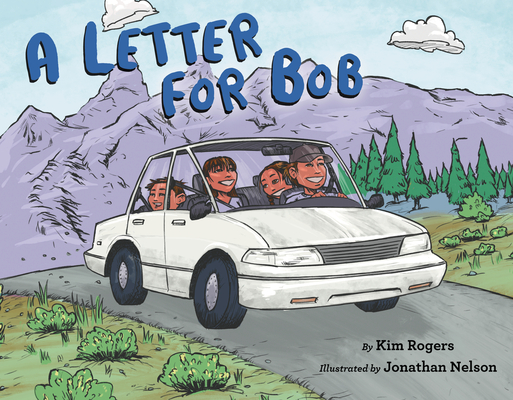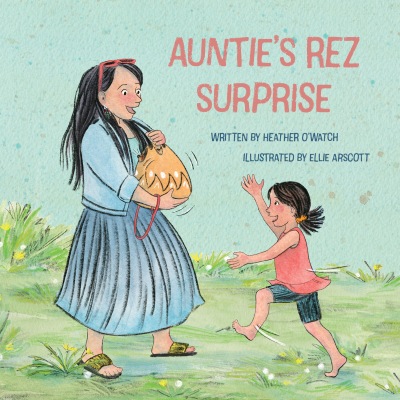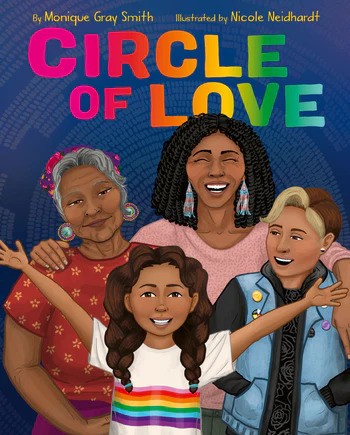By Angeline Hoffman, White Mountain Apache Tribe
 This month I celebrate global children’s books focused on Indigenous families. Today in the U.S. there are 574 different federally recognized Indigenous tribes. While many teachers see the usefulness of celebrating American Indians during October and November holidays (October 14, Indigenous Peoples’ Day and November – Indigenous Heritage Month), we need to move beyond single days and months to explore Indigenous cultures. Much like the hazards of limiting the study of African American life to Black History Month in February, I hope teachers will ponder how we can explore Indigenous families and life as a part of any literature, history, art or science exploration throughout the school year.
This month I celebrate global children’s books focused on Indigenous families. Today in the U.S. there are 574 different federally recognized Indigenous tribes. While many teachers see the usefulness of celebrating American Indians during October and November holidays (October 14, Indigenous Peoples’ Day and November – Indigenous Heritage Month), we need to move beyond single days and months to explore Indigenous cultures. Much like the hazards of limiting the study of African American life to Black History Month in February, I hope teachers will ponder how we can explore Indigenous families and life as a part of any literature, history, art or science exploration throughout the school year.
Strong Nations is a useful publisher as I continually search for Indigenous children’s books. My goal in working with fifth and sixth grade Apache and Navajo students is to share books that value their culture, thereby empowering them. This month I focus on five children’s books that center on Indigenous families.
Kim Rogers introduces us to a family whose beloved car, named: Bob, takes them to pow wows, on vacations and even helps them survive a few scary times. As I read A Letter for Bob (2023), I recalled my younger sister’s first car, a white, two door Ford. Since she was single, everyone called her car Lonesome Dave. In the classroom, teachers could invite students to reveal names of family cars or ask students to name one of their treasured vehicles. Students could then write and share their own car adventures with their classmates and families.
A second book by author Kim Rogers, Just Like Grandma (2023), highlights intergenerational bonds between grandparents and grandchildren. Grandma teaches Becca cultural lessons focused on beading moccasins, painting and dancing at the powwow. In turn, Becca teaches Grandma about her love of basketball while Grandpa keeps them well-fed with fried chicken or to:kic and white bread. This story reminds me of my connections with my granddaughter through beading, knitting, and reading. Life is full of learning new experiences through our precious Elders and grandchildren.
 In the Indigenous culture, canines hold a unique place as relatives who need special care. In Auntie’s Rez Surprise by Heather O’Watch and illustrator Ellie Arscott (2023), Cree’s auntie brings her a special surprise from the rez during a memorable visit. Auntie’s wiggling bag finally reveals a new family member – a rez puppy! In this tale from the Okanese First Nation, we see the importance of Elders who use stories to reveal their culture’s values and beliefs through stories. We also can explore the deep knowledge of Native Nations’ bonds between family members.
In the Indigenous culture, canines hold a unique place as relatives who need special care. In Auntie’s Rez Surprise by Heather O’Watch and illustrator Ellie Arscott (2023), Cree’s auntie brings her a special surprise from the rez during a memorable visit. Auntie’s wiggling bag finally reveals a new family member – a rez puppy! In this tale from the Okanese First Nation, we see the importance of Elders who use stories to reveal their culture’s values and beliefs through stories. We also can explore the deep knowledge of Native Nations’ bonds between family members.
What child doesn’t love to play in the rain? Benjamin’s love of rainy days, especially those that bring thunder, reminds him of his grandfather’s drum. This also reminds me of my husband who would go out in the rain and welcome the rain with open arms. In Benjamin’s Thunderstorm (2023), this young child ponders his dad and the powwow dancers as they spin in time to the drumbeat. Award winning author Melanie Florence enables us to celebrate the Cree powwow culture by weaving Cree words for weather and color (osawi = orange) into this family story. Teachers can easily use this book to explore fiction within a nonfiction study of weather.
 In Circle of Love (2024), meet Molly, who invites readers to join her for a feast at an Intertribal Community Center. She introduces us to her family and friends: uncles, grandmother and her wife, cousins and friends. Native families are blood related, clan related and close friends. Monique Gray Smith’s heartwarming text reminds us that love is love. Through her website, you can listen to Monique and her colleague explore avenues for talking with children about various topics like residential schools.
In Circle of Love (2024), meet Molly, who invites readers to join her for a feast at an Intertribal Community Center. She introduces us to her family and friends: uncles, grandmother and her wife, cousins and friends. Native families are blood related, clan related and close friends. Monique Gray Smith’s heartwarming text reminds us that love is love. Through her website, you can listen to Monique and her colleague explore avenues for talking with children about various topics like residential schools.
I close by urging teachers to explore another publishing house from Canada, Orca Book Publishers, who offers books for curious preschoolers through adolescent readers. I also recommend using online resources like this one available from the Smithsonian’s American Indian Museum. I invite you to find the time to locate stories about Indigenous families and their ways of knowing, ones that empower and affirm their historical as well as current contributions, thereby ensuring, “We’re here. We’ve always been here.” (National Museum of the American Indian – Native Knowledge 360 degrees, 2024)
WOW Currents is a space to talk about forward-thinking trends in global children’s and adolescent literature and how we use that literature with students. “Currents” is a play on words for trends and timeliness and the way we talk about social media. We encourage you to participate by leaving comments and sharing this post with your peers. To view our complete offerings of WOW Currents, please visit its archival stream.
